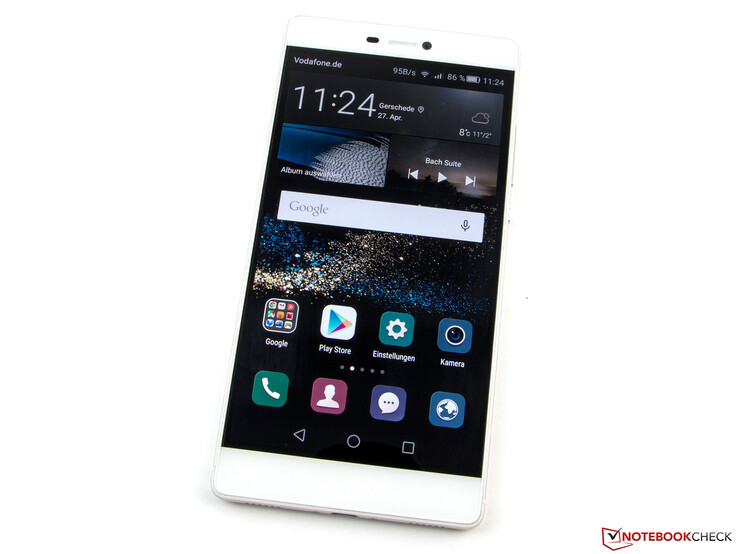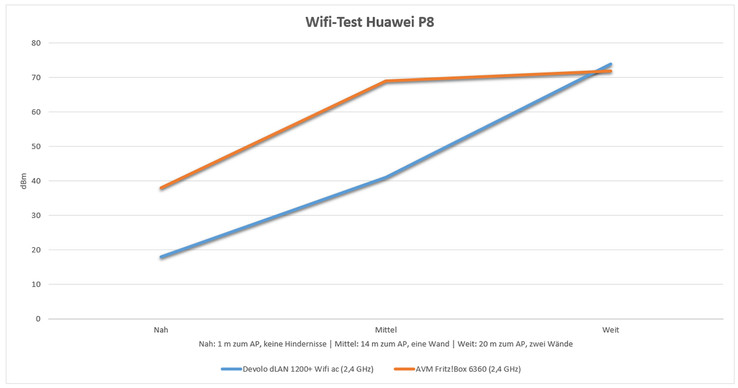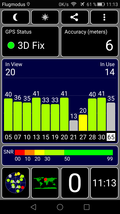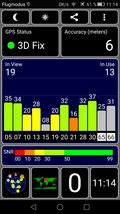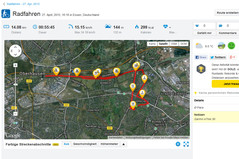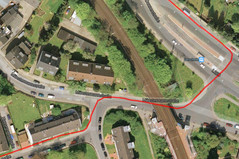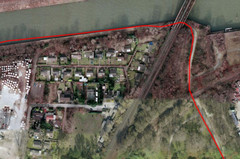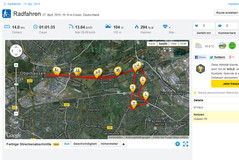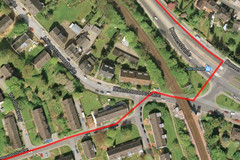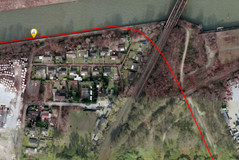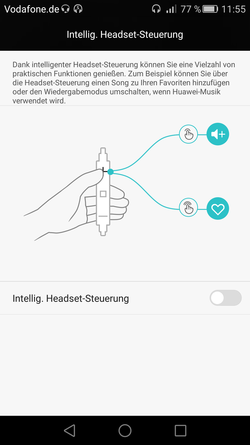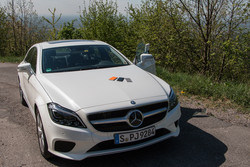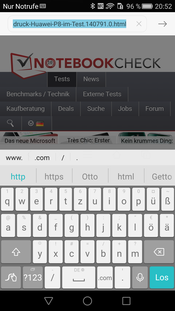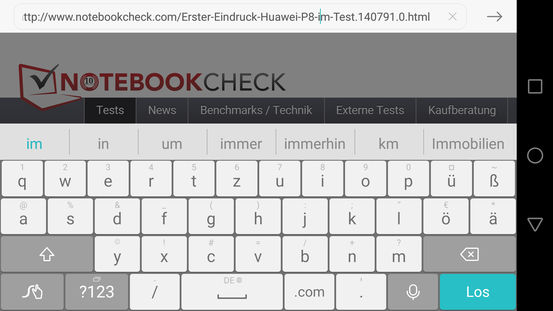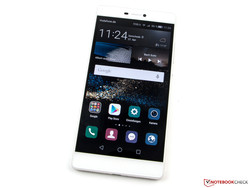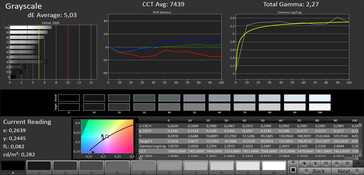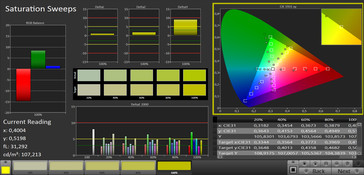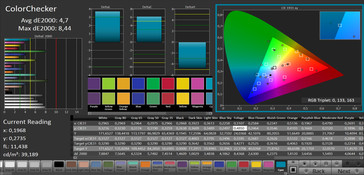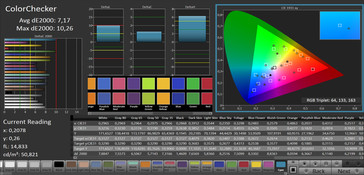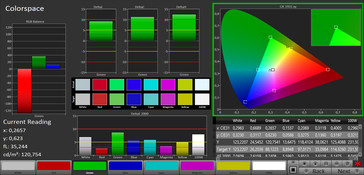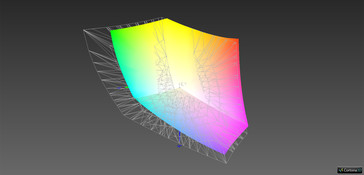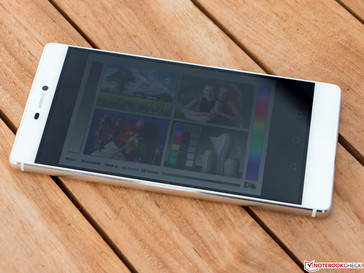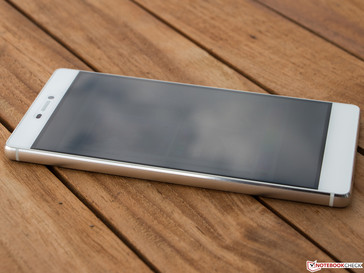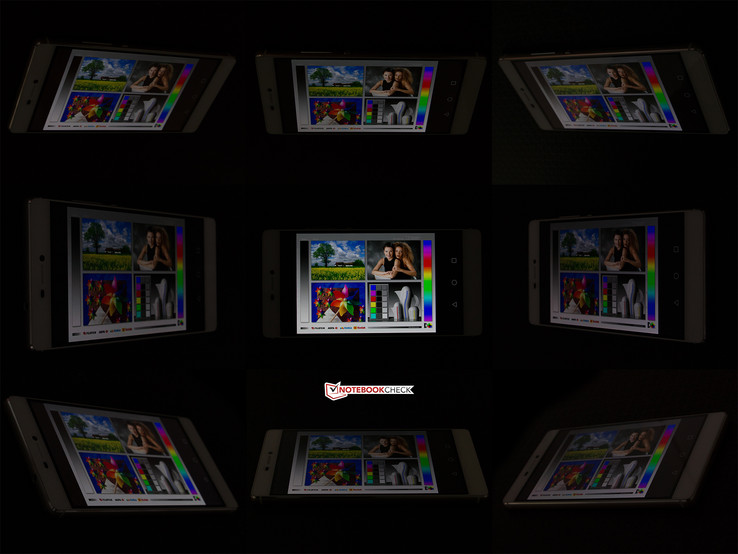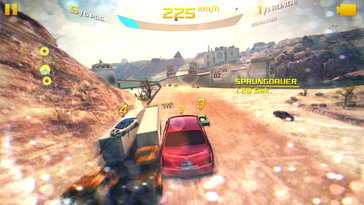Huawei P8 Smartphone Review
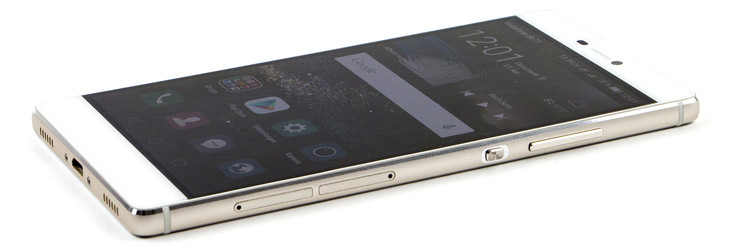
For the original German review, see here.
Huawei introduced its latest premium smartphone P8 in London. The manufacturer will waive the model designation "Ascend" from now on. Compared to the predecessor, Ascend P7, the new model is slightly larger and uses a 5.2-inch screen. Thanks to the Full HD resolution, the contents are razor-sharp. It has 3 GB of memory, and the internal storage has a capacity of 16 GB. You can also get a premium version of the smartphone: For 100 Euros (~$114) extra, you quadruple the storage capacity (64 GB) with a slightly faster Kirin 935 processor. Our test model, which represents the smaller version, uses Huawei’s own Kirin 930. The new camera is a very important aspect of the P8 smartphone. Although it does not have a higher resolution, it is supposed to take very good pictures in difficult lighting conditions and offers some special features that we will evaluate over the course of the review.
The competition is usually more expensive than the Huawei P8 (starting from 499 Euros; ~$568, RRP). Only the OnePlus One (349 Euros; ~$397 plus shipping) costs less. The list of rivals includes the Samsung Galaxy S6 and S6 Edge, the HTC One M9, the Sony Xperia Z3, the LG G3, the Nokia Lumia 930, the Apple iPhone 6 Plus, the Google Nexus 6 and the Motorola Moto X.
Case
With a height of 6.4 millimeters (~0.25 in) the Huawei P8 is slightly slimmer than the predecessor (6.5 mm; ~0.26 in, 124 g; ~4.4 oz). However, it is slightly heavier and now weighs 147 grams (~5.2 oz). The weight is actually good for the smartphone and creates certain sophistication, but still feels good in the hand. This means it is the slimmest smartphone amongst the premium devices and it is even slightly thinner than the Samsung Galaxy S6 Edge (7.0 mm, 132 g; ~0.28 in, ~4.7 oz) or the iPhone 6 Plus (7.1 mm, 172 g; ~2.8 in, ~6.1 oz).
The chassis of the Huawei P8 is mainly made of aluminum; Corning’s Gorilla Glass 4 protects the other parts. This is especially important for the panel because the further improved protection glass is supposed to be particularly scratch resistant. The manufacturer has also added a protective cover for the display. Despite the slim contour, you can hardly twist the smartphone and there is no creaking. Pressure is not a problem and only a lot of force on the screen can result in ripples on the panel. The gaps are accurate and even.
The battery of the P8 is integrated and cannot be replaced by the user. The covers of the two card slots are flush with the case, so the Huawei P8 leaves a great impression with regard to the build quality and materials. Another nice aspect is that the camera is not protruding from the aluminum chassis.
Connectivity
The Micro-USB 2.0 port of the Huawei P8 can be used to charge the smartphone or transfer files from a computer. Tethering is possible as well and OTG is supported, so you can attach external input devices or storage solutions to the P8. MHL is not available, so you will have to use DLNA or Miracast if you want to watch media contents on external displays.
Our review version (GRA-L09) has two card slots, one for the Nano-SIM card and one for storage expansions via MicroSD card. There will also be models with a hybrid slot, where the second slot can be used for SIM as well as memory cards. However, this feature is reserved for the dual-SIM LTE version. Whether this version will be available in Europe is not decided yet. The smartphone supports memory cards with a capacity of up to 128 GB.
NFC and FM radio are also integrated. Unfortunately, charging the smartphone wirelessly is not possible.
Software
The Huawei P8 uses Google Android 5.0 Lollipop with the user interface EMUI 3.1, which does not use an App Drawler. You can customize the design via Design app. Once again, the Phone Manager, already familiar from the older versions, is included and can be used to optimize the smartphone system.
A new feature is the Director’s mode. The app can connect the smartphone with up to three more Android smartphones and allows access to their cameras. The master device can easily switch between its own and the other cameras and record the results seamlessly. You can also give instructions to the users of the other devices. The owner of the P8 has to share the app directly with other users since it is not currently available on the Play Store. If you have received the app, you can only use it to a limited extent and just enter a group. All the features are reserved for the P8. Unfortunately, the quality of the recordings is limited to 720p.
Communication & GPS
Mobile Internet connections on the Huawei P8 can be established via HSPA+ (upload up to 5.76 Mbps, download up to 42 Mbps) or LTE Cat. 4 (upload up to 50 Mbps, download up to 150 Mbps). The Kirin 930 SoC would also support LTE Cat. 6 (up to 300 Mbps), but Huawei has decided to use the older standard because it would ensure a better signal quality due to the slim design of the smartphone, at least this was the response from the manufacturer. It is still unfortunate, especially since LTE Cat. 9 is already possible. The technology Signal+ is supposed to ensure a good reception for fast movements, for example on a train or in a car.
The WLAN connectivity is not up to date. You only get a WLAN module that supports the IEEE-802.11 standards b/g/n, so you can only use 2.4 GHz networks. We would have expected at least dual-band Wi-Fi, let alone the AC standard. However, the component has a very good reception and we had a very good signal quality 20 meters (~66 ft) away from the access point (AP) and there were no restrictions for web browsing. The damping factor in direct proximity to the AP was sometimes just -17 dBm, a new record. It is also helpful that the smartphone can automatically switch between WLAN and the mobile data connection if it notices that one connection provides a better quality. The same applies for switching between multiple Wi-Fi networks, which is very convenient if you have more than one network at home or the office.
The Bluetooth 4.1 LE is supported by the latest version. The range was very good during audio streaming, and the stability was impressive. We did not notice any dropouts during music playback.
You can locate your position via GPS, GLONASS and BeiDou, so a precise location should be possible all over the world. The satellite fix was very fast, even in the indoors, with an accuracy of within six meters (~20 ft). The performance is slightly better outdoors, where, according to the app GPS Test the accuracy fluctuated between four and six meters (~13 and ~20 ft).
We compare the accuracy of the location with the professional navigation device Garmin eTrex 30 on a bicycle ride. This test does reveal some weaknesses, and it seems that the connection with the satellites was occasionally lost. The P8 sometimes takes a shortcut and does not always follow the route exactly, like the road crossing, which should start in the right lane between the traffic island and the tram stop. The dense ride along the canal bank is difficult for both devices. Along the way, the signal is affected by trees and a railway bridge. The P8 just leaves this part of the track out, while the eTrex 30 follows the route exactly. However, the overall deviations are not that big, so the performance of the review unit is still decent, despite some small issues.
Telephone & Voice Quality
The Huawei P8 offers some nice features to improve the voice quality, including a suppression from environmental and wind noises (up to 90%). This is made possible by a separately integrated digital audio processor (DSP) and in practice, the result is noticeable. If we hold the smartphone directly to our ear, there was nothing to hear from the background music and strong wind was only occasionally audible in the outdoors. We are also very satisfied with the signal quality because we could easily hear the person on the other side of the call, and the same applies to our voice.
The speaker of the P8 is also supposed to be well suited for conferences. This also worked well in the review: Even at a distance of two meters (~7 ft) from the device, we were easy to understand, but the voices sound slightly tinny.
The provided headset does a good job. The sound is slightly too focused on bass, but the microphone left a great impression. The small control element can also be used to control calls and the music playback.
Cameras
The front camera of the Huawei P8 takes pictures with up to 8 MP (up to 3264x2448 px, 4:3). If six megapixels are sufficient, then you can also shoot in 16:9 or 1:1. The improvement mode includes a ten-stage soft focus. The results are quite good under good light conditions and you will be satisfied if you like to take selfies. A nice feature for groufies is the panorama mode of the front camera. It takes a classic selfie first and then another picture to the left and right side, which will be put together automatically. Filters that were used are directly displayed. Therefore, the result is directly visible on the screen, following the motto "What you see is what you get".
The main camera at the back also supports this feature, but it can also be used for the HDR mode. As with the predecessor, the sensor has a maximum resolution of 13 MP (up to 4160x3120 px, 4:3). This is no longer provided by Sony but developed in-house and is supposed to deliver a much higher quality. In addition to an f/2.0 aperture, you get an auto focus, a four-color RGBW sensor and an optical image stabilizer. The latter can be deactivated, which is an advantage if you want to use the smartphone on a tripod. The picture quality has improved significantly compared to the predecessor. Our comparison shots were taken during the "One night at the Europa-Park 2015 (#mbep15)" event. At this point, we want to thank Mercedes Benz and Microsoft for the invitation.
The daylight pictures of the Huawei P8 did impress us. Although you can see a slight blue cast, the colors are natural. The sharpness is good and there is no cause for criticism. The positive impression continues in the twilight, and the image stabilizer still ensures sharp results. Here we can actually see the differences between the devices. While the P8 and the Lumia 930 take sharp pictures, the results of the LG G3 show some fragments. The P8 shows off its strength in little light, and with artificial back-light (scene 4). Despite the poor lighting conditions, the pictures are still comparatively sharp and the colors are natural, while the Lumia has to fight with the back-light and the colors of the G3 become quite pale. The smartphone from LG also loses sharpness of the contours.
The sensor of the review unit is also very fast. It is possible to activate the camera app from standby and take a picture with a double tap on the lower volume button. Moreover, this takes just one second. Even in unfavorable lighting conditions, it never took longer than 1.6 seconds. A very fast result. Overall, the camera of the Huawei P8 is impressive and takes very good pictures.
Panoramic pictures also work very well on the Huawei P8 if you have a steady hand. Edges are clean and the lighting is good. In terms of sharpness, the Lumia 930 is slightly better, but it uses up to five individual shots instead of a continuous panorama.
Another nice feature of the Huawei P8 is the so-called light painting. It is a simplified long-term exposure that enables you to paint with light and easily capture it in a single picture. The user just has to press the trigger, move a light in the dark in front of the camera and stop the recording afterwards. The smartphone combines the individual pictures and creates one.
This works quite well in practice and with a little effort and some practice can create great results.
Videos on the Huawei P8 can be recorded in Full HD (1920x1080 pixels, 16:9, 30 fps). Unfortunately, it is not possible to take Ultra-HD videos or select higher frame rates, which would be useful for slow-motion videos. The sound is recorded in stereo and leaves a decent impression. The quality of the videos is good, even in difficult lighting conditions.
Accessories
Even though the manufacturer uses cardboard and plastic in the packaging, the box of the smartphone is quite nice and elegant (see the unboxing video above). You get a modular power adaptor (5 W, 5 V, 1 A), a USB cable, a small tool to open the card slots and a headset. Optional accessories are the DotView covers that are already familiar from HTC.
Warranty
The Huawei P8 offers a two-year warranty that cannot be extended.
Input Devices & Handling
The main input element of the Huawei P8 is the 5.2-inch capacitive touchscreen. It recognizes up to 10 inputs simultaneously and can differentiate between inputs with the fingers and inputs with the knuckles. Huawei calls the latter Knuckle-Touch and advertises it as the next generation of touch inputs. We would not go that far, especially since for the time being, the additional gestures are limited to taking screenshots. A double knock creates a screenshot or you can use the knuckles to draw a circle around the part you want to save.
The gliding capabilities of the surface are very good. Inputs are executed quickly and reliably, and we could not notice any restrictions in the peripheral areas. The physical buttons for the power and the volume rocker have clear and firm pressure points.
The keyboard layout is sophisticated and directly integrates country-specific keys. Only a separate row for numbers is missing. Swipe inputs are supported, and automatic word predictions are situated above the keyboard. The solution for single-handed operation is clever: The whole display content gets smaller when you swipe across the Android buttons and can easily be operated with the thumb. This works for left as well as right-handers.
Display
Huawei has equipped the P8 with a 5.2-inch IPS Neo screen and a resolution of 1920x1080 pixels, which results in a screen ratio of 16:9 and a high pixel density of 424 ppi. The latter is slightly lower compared to the Ascend P7 because the size of the panel has increased, but the result is still razor-sharp.
The luminosity is decent and we can measure 439 cd/m² on average. The brightness distribution is very even at 91%, but the P7 (470 cd/m², 92%) was actually slightly better. However, this is still a very good result within the comparison devices, only the HTC One M9 (458 cd/m², 85%) and the iPhone 6 Plus (496 cd/m², 90%) are brighter.
| |||||||||||||||||||||||||
Brightness Distribution: 91 %
Center on Battery: 453 cd/m²
Contrast: 1618:1 (Black: 0.28 cd/m²)
ΔE ColorChecker Calman: 4.7 | ∀{0.5-29.43 Ø4.78}
ΔE Greyscale Calman: 5.03 | ∀{0.09-98 Ø5}
72.04% AdobeRGB 1998 (Argyll 1.6.3 3D)
Gamma: 2.27
CCT: 7439 K
| Huawei P8 Mali-T628 MP4, Kirin 930, 16 GB eMMC Flash | HTC One M9 Adreno 430, 810 MSM8994, 32 GB eMMC Flash | OnePlus One Adreno 330, 801 MSM8974AC, 64 GB eMMC Flash | Google Nexus 6 Adreno 420, 805 APQ8084, 32 GB eMMC Flash | Samsung Galaxy S6 Edge Mali-T760 MP8, Exynos 7420, 32 GB UFS 2.0 Flash | Apple iPhone 6 Plus PowerVR GX6450, A8, 64 GB eMMC Flash | Nokia Lumia 930 Adreno 330, 800 MSM8974, 32 GB eMMC Flash | |
|---|---|---|---|---|---|---|---|
| Screen | -18% | -34% | -22% | 14% | -14% | -55% | |
| Brightness middle (cd/m²) | 453 | 474 5% | 423 -7% | 274 -40% | 343 -24% | 519 15% | 275 -39% |
| Brightness (cd/m²) | 439 | 458 4% | 408 -7% | 264 -40% | 338 -23% | 496 13% | 278 -37% |
| Brightness Distribution (%) | 91 | 85 -7% | 83 -9% | 89 -2% | 94 3% | 90 -1% | 89 -2% |
| Black Level * (cd/m²) | 0.28 | 0.4 -43% | 0.54 -93% | 0.62 -121% | |||
| Contrast (:1) | 1618 | 1185 -27% | 783 -52% | 837 -48% | |||
| Colorchecker dE 2000 * | 4.7 | 6.32 -34% | 5.56 -18% | 6.99 -49% | 2.2 53% | 3.67 22% | 10.99 -134% |
| Greyscale dE 2000 * | 5.03 | 6.36 -26% | 7.55 -50% | 4.01 20% | 2.37 53% | 3.78 25% | 8.29 -65% |
| Gamma | 2.27 97% | 2.43 91% | 2.33 94% | 2.03 108% | 2.41 91% | 2.42 91% | 2.16 102% |
| CCT | 7439 87% | 8218 79% | 7624 85% | 6329 103% | 6425 101% | 7327 89% | 6731 97% |
| Color Space (Percent of AdobeRGB 1998) (%) | 72.04 | 58.81 -18% | 87.77 22% |
* ... smaller is better
The new IPS technology is noticeable in terms of the black value. The Huawei P8 manages an excellent result of 0.28 cd/m², which is the best value that we have been able to measure for an LC display so far. This results in a great contrast of 1618:1. Only smartphones with AMOLED screens like the Galaxy S6 or the Nexus 6 can manage better results.
We tested the color accuracy of the review unit with a spectrophotometer and the software CalMAN. The grayscale reveals a slightly visible shift towards blue and green, but this is not an issue in practice. The color temperature can be manually adjusted in the settings, but this will actually reduce the accuracy and the deviations of the ColorChecker in particular will get bigger. The results are quite good ex-works with an average DeltaE value of 4.7. However, the panels from the flagship devices like the Galaxy S6 Edge (dE 2.2) and the iPhone 6 Plus (dE 3.7) are noticeably better. The P8 shows significantly more visible deviations from the ideal value for green colors in particular, which are more saturated. The panel can cover almost the whole sRGB color space, so it is one of the best IPS displays that you can currently get for a smartphone.
The Huawei P8 leaves a decent impression outdoors. The high contrast and good luminance ensure that the display content is visible in bright environments. Only the glossy surface can be a problem in some situations, but the overall outdoor capabilities of the P8 are still good.
Performance
The P8 uses Huawei’s own 64-bit SoC HiSilicon Kirin 930. The octa-core processor consists of two quad-core clusters of Cortex-A53 cores, which run with 2.0 and 1.5 GHz, respectively. The manufacturer had to modify the design slightly to reach such high frequencies and use Coretx-A53e cores for the faster cluster. Huawei has discarded the more powerful Cortex-A57 cores completely, so the performance cannot keep up with the Exynos 7420 or Snapdragon 810. The SoC is supported by 3 GB of memory and the ARM Mali-T628 MP4 GPU. The latter has already been used for the Kirin 920, which can be found inside the Honor 6.
The lack of the fast Cortex-A57 cores, which are around 60% faster than the less powerful A53 cores, affects the benchmark results. This also means that even older SoCs can be faster than the modern Kirin 930 when you just use a few threads. This is visible in the Geekbench 3 Single-Core test, where the Honor 6 is much faster than the review unit and the same applies for Smartbench 2012. The P8 performs very well in applications optimized for multi-core workloads and a 64-bit architecture. It can convince in AnTuTu v5 and beats many rivals with Snapdragon 801 processors. It is even faster than the HTC One M9 (Snapdragon 810) in PCMark for Android and is only beaten by the Samsung Galaxy S6 Edge (Exynos 7420).
The difference compared with the high-end competition is more noticeable in the graphics benchmarks, where the Huawei P8 often falls behind. Flagship devices like the One M9 and the Galaxy S6 can be more than five times faster. Even the Lumia 930 (Snapdragon 800, Adreno 330) manages a 50% higher frame rate in the older GFXBenchmark 2.7. Unfortunately, at the time the review, the modern 3DMark Sling Shot did not yet support the Huawei P8.
The subjective performance impression is very smooth and apps run fast.
| AnTuTu v5 - Total Score (sort by value) | |
| Huawei P8 | |
| OnePlus One | |
| LG G3 | |
| Motorola Moto X 2. Gen 2014 | |
| HTC One M9 | |
| Sony Xperia Z3 | |
| Google Nexus 6 | |
| Samsung Galaxy S6 Edge | |
| Apple iPhone 6 Plus | |
| Honor 6 | |
| Geekbench 3 | |
| 32 Bit Single-Core Score (sort by value) | |
| Huawei P8 | |
| Huawei Ascend P7 | |
| OnePlus One | |
| LG G3 | |
| Motorola Moto X 2. Gen 2014 | |
| HTC One M9 | |
| Sony Xperia Z3 | |
| Google Nexus 6 | |
| Samsung Galaxy S6 Edge | |
| Apple iPhone 6 Plus | |
| Honor 6 | |
| 32 Bit Multi-Core Score (sort by value) | |
| Huawei P8 | |
| Huawei Ascend P7 | |
| OnePlus One | |
| LG G3 | |
| Motorola Moto X 2. Gen 2014 | |
| HTC One M9 | |
| Sony Xperia Z3 | |
| Google Nexus 6 | |
| Samsung Galaxy S6 Edge | |
| Apple iPhone 6 Plus | |
| Honor 6 | |
| 64 Bit Single-Core Score (sort by value) | |
| Huawei P8 | |
| HTC One M9 | |
| Samsung Galaxy S6 Edge | |
| 64 Bit Multi-Core Score (sort by value) | |
| Huawei P8 | |
| HTC One M9 | |
| Samsung Galaxy S6 Edge | |
| PCMark for Android - Work performance score (sort by value) | |
| Huawei P8 | |
| OnePlus One | |
| LG G3 | |
| LG G3 | |
| HTC One M9 | |
| Samsung Galaxy S6 Edge | |
| Honor 6 | |
| 3DMark | |
| 1280x720 offscreen Ice Storm Unlimited Score (sort by value) | |
| Huawei P8 | |
| Huawei Ascend P7 | |
| OnePlus One | |
| LG G3 | |
| Motorola Moto X 2. Gen 2014 | |
| HTC One M9 | |
| Sony Xperia Z3 | |
| Google Nexus 6 | |
| Samsung Galaxy S6 Edge | |
| Apple iPhone 6 Plus | |
| Honor 6 | |
| 1280x720 offscreen Ice Storm Unlimited Graphics Score (sort by value) | |
| Huawei P8 | |
| Huawei Ascend P7 | |
| OnePlus One | |
| LG G3 | |
| Motorola Moto X 2. Gen 2014 | |
| HTC One M9 | |
| Sony Xperia Z3 | |
| Google Nexus 6 | |
| Samsung Galaxy S6 Edge | |
| Apple iPhone 6 Plus | |
| Honor 6 | |
| 1280x720 offscreen Ice Storm Unlimited Physics (sort by value) | |
| Huawei P8 | |
| Huawei Ascend P7 | |
| OnePlus One | |
| LG G3 | |
| Motorola Moto X 2. Gen 2014 | |
| HTC One M9 | |
| Sony Xperia Z3 | |
| Google Nexus 6 | |
| Samsung Galaxy S6 Edge | |
| Apple iPhone 6 Plus | |
| Honor 6 | |
| GFXBench 3.0 | |
| on screen Manhattan Onscreen OGL (sort by value) | |
| Huawei P8 | |
| OnePlus One | |
| LG G3 | |
| Motorola Moto X 2. Gen 2014 | |
| HTC One M9 | |
| Sony Xperia Z3 | |
| Google Nexus 6 | |
| Samsung Galaxy S6 Edge | |
| Apple iPhone 6 Plus | |
| Honor 6 | |
| 1920x1080 1080p Manhattan Offscreen (sort by value) | |
| Huawei P8 | |
| OnePlus One | |
| LG G3 | |
| Motorola Moto X 2. Gen 2014 | |
| HTC One M9 | |
| Sony Xperia Z3 | |
| Google Nexus 6 | |
| Samsung Galaxy S6 Edge | |
| Apple iPhone 6 Plus | |
| Honor 6 | |
| Basemark X 1.1 - High Quality (sort by value) | |
| Huawei P8 | |
| Huawei Ascend P7 | |
| OnePlus One | |
| LG G3 | |
| Motorola Moto X 2. Gen 2014 | |
| HTC One M9 | |
| Sony Xperia Z3 | |
| Samsung Galaxy S6 Edge | |
| Honor 6 | |
The performance of the Huawei P8 in the browser benchmarks is not very good with the preset browser. In some cases, the results are clearly behind the other flagship devices. However, subjectively web browsing is quite fast.
| Peacekeeper - --- (sort by value) | |
| Huawei P8 | |
| Huawei Ascend P7 | |
| OnePlus One | |
| LG G3 | |
| Nokia Lumia 930 | |
| Motorola Moto X 2. Gen 2014 | |
| HTC One M9 | |
| Sony Xperia Z3 | |
| Samsung Galaxy S6 Edge | |
| Apple iPhone 6 Plus | |
| Honor 6 | |
| Browsermark - 2.1 (sort by value) | |
| Huawei P8 | |
| OnePlus One | |
| LG G3 | |
| LG G3 | |
| Nokia Lumia 930 | |
| Motorola Moto X 2. Gen 2014 | |
| HTC One M9 | |
| Samsung Galaxy S6 Edge | |
| Honor 6 | |
| Vellamo 3.x - Browser (sort by value) | |
| Huawei P8 | |
| OnePlus One | |
| LG G3 | |
| LG G3 | |
| Motorola Moto X 2. Gen 2014 | |
| HTC One M9 | |
| Sony Xperia Z3 | |
| Google Nexus 6 | |
| Samsung Galaxy S6 Edge | |
| Honor 6 | |
* ... smaller is better
This version of the Huawei P8 has 16 GB of internal eMMC flash storage and the user can use around 11.5 GB. It is also possible to use a MicroSD card if you do not want to get the premium version with 64 GB of internal storage. The MicroSD card is an inexpensive method to expand the storage by up to 128 GB. App2SD is also supported.
Compared to the predecessor, the performance of the storage has improved noticeably, but is only average within the high-end segment. Only the reading performance of small files is very convincing and the P8 is only beaten by the Galaxy S6 Edge.
| BaseMark OS II - Memory (sort by value) | |
| Huawei P8 | |
| OnePlus One | |
| LG G3 | |
| Nokia Lumia 930 | |
| Motorola Moto X 2. Gen 2014 | |
| HTC One M9 | |
| Google Nexus 6 | |
| Samsung Galaxy S6 Edge | |
| Apple iPhone 6 Plus | |
| Honor 6 | |
Games
The Huawei P8 is certainly not for gaming enthusiasts, but the performance of the ARM Mali-T628 MP4 is still sufficient to play for example, “Asphalt 8” smoothly with the highest settings, and we could rarely notice small stutters. Simpler games like “Angry Birds”, “Clash of Clans” or “Anno” are not a problem for the smartphone. However, upcoming games with a high technical standard could be too demanding for the P8.
The clean operating sensors and the great touchscreen do not affect the gaming experience. The speakers also deliver a good sound.
Emissions
Temperature
The surface temperatures of the Huawei P8 leave a good impression, which is mainly a result of the weak SoC. At a maximum of 33.2 °C (~92 °F); the smartphone does not even get lukewarm while idling. The temperatures are not much higher under sustained load, and the measured 35.7 °C (~96 °F) is a very low result.
Unfortunately, we can measure higher temperatures underneath the surface. We use a stress test with the GFXBenchmark battery test to check the clocks of the SoC under sustained load. The T-Rex Onscreen test is repeated thirty times. With 11 fps, it does not run smoothly on the P8, but the performance is further reduced after the first run. The smartphone loses more performance over the course of the benchmark and the difference is around 40% at the end of the test.
(+) The maximum temperature on the upper side is 35.7 °C / 96 F, compared to the average of 35.2 °C / 95 F, ranging from 21.9 to 247 °C for the class Smartphone.
(+) The bottom heats up to a maximum of 31.3 °C / 88 F, compared to the average of 34 °C / 93 F
(+) In idle usage, the average temperature for the upper side is 29.6 °C / 85 F, compared to the device average of 32.9 °C / 91 F.
Speakers
The two speakers at the bottom of the smartphone frame are certainly not perfectly located, but they sound comparatively good and can be very loud. The sound stays quite balanced up to 60% of the maximum volume and is sufficient for the occasional music playback if you do not have external speakers. Medium tones are audible and there is even some bass, but the smartphone does not oscillate. You will have to live with a tinny sound and some echoes when you turn up the volume. It is still quite a good component for a smartphone, but it cannot compete with the HTC One M9.
The stereo jack leaves a good subjective impression and the sound output is very clear. The provided headphones are not suited for music playback since the sound is very unbalanced and muffled.
Energy Management
Power Consumption
The power consumption of the Huawei P8 is surprisingly high, which seems to be caused by the display in particular. The consumption is heavily increased with the maximum luminance and it can increase the idle consumption up to 2.0 watts without a wireless connection.
The values are also very high under load with up to 7.4 watts, so the P8 is similar to the One M9 (up to 7.5 watts) and consumes even more power than the Galaxy S6 Edge (up to. 6.8 watts), even though both rivals have much more powerful SoCs.
The power adaptor is not powerful enough with a nominal output of 5 watts. Quick Charge is not supported, so a complete charge of the smartphone takes more than three hours.
| Off / Standby | |
| Idle | |
| Load |
|
Key:
min: | |
Battery Runtime
The battery capacity of the Huawei P8 is quite generous at 2680 mAh when you consider the slim construction, but the high power consumption prevents good runtimes on par with the rivals in some scenarios. The stamina of the P8 in the Reader’s Test is rather short; all the rivals except for the HTC One M9 last longer. On the other hand, the P8 manages better results than the rivals under load. The runtimes with an adjusted display brightness are average at best within the comparison, but more than seven hours in the WLAN test and almost ten hours in the video test are still quite good results.
We were able to test the Huawei P8 for quite a while and can report that you should have no problem to manage a whole day, even with intense use of the smartphone. Our battery charge lasted for 36 hours, but you will have to charge the smartphone in the evening if you use the camera frequently.
| Huawei P8 Mali-T628 MP4, Kirin 930, 16 GB eMMC Flash | Samsung Galaxy S6 Edge Mali-T760 MP8, Exynos 7420, 32 GB UFS 2.0 Flash | HTC One M9 Adreno 430, 810 MSM8994, 32 GB eMMC Flash | Sony Xperia Z3 Adreno 330, 801 MSM8974AC, 16 GB eMMC Flash | Motorola Moto X 2. Gen 2014 Adreno 330, 801 MSM8974AC, 16 GB eMMC Flash | Nokia Lumia 930 Adreno 330, 800 MSM8974, 32 GB eMMC Flash | Apple iPhone 6 Plus PowerVR GX6450, A8, 64 GB eMMC Flash | |
|---|---|---|---|---|---|---|---|
| Battery runtime | 16% | -11% | 8% | 4% | 24% | 27% | |
| Reader / Idle (h) | 13.8 | 22.5 63% | 13.4 -3% | 20.1 46% | 18 30% | 23.1 67% | 23.9 73% |
| H.264 (h) | 9.7 | 7 -28% | 7 -28% | 11.4 18% | 10.1 4% | 11.3 16% | |
| WiFi v1.3 (h) | 7.2 | 8.9 24% | 5.8 -19% | ||||
| Load (h) | 3.6 | 3.7 3% | 3.9 8% | 2.2 -39% | 2.8 -22% | 2.9 -19% | 3.3 -8% |
| WiFi (h) | 9.6 | 11.2 | 10.3 | 16.7 | 13 |
Pros
Cons
Verdict
The Huawei P8 shows that the Chinese can build very good smartphones. The device can impress in many areas and can compete with the much more expensive rivals from Samsung, HTC and Apple.
Our review unit uses the high-quality materials, a mix of aluminum and glass as well as a slim construction. The display looks very good and even without QHD resolution, the measurements are very good. The camera takes good pictures, even in difficult lighting conditions and the communication modules work very well.
Huawei can still improve a few things. Connectivity in particular lacks some features. By now, WLAN-AC should be standard in this price range, and we would have liked to see LTE Cat. 6. The performance does not really remind us of a high-end smartphone.
The P8 is Huawei’s best smartphone so far.
However, if you look at the RRP of just 499 Euros (~$568) you can quickly see that Huawei offers a lot of smartphone for the money. If you want to buy one of the better-equipped rivals, you will get more modern communication modules, maybe a slightly better display or a better camera, but you will have to pay a few hundred Euros/Dollars more. We think the P8 is a successful smartphone with a great price/performance ratio.
Huawei P8
- 05/05/2015 v4 (old)
Daniel Schmidt




